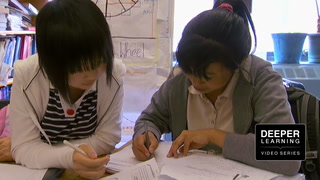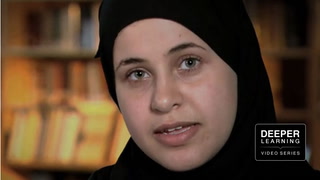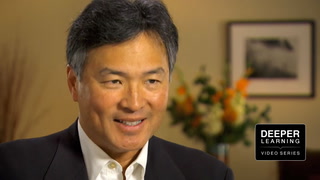Series Internationals Network Deeper Learning: Supporting ELLs Through Project-Based Learning
Save to My Resources
PLEASE CREATE A NEW ACCOUNT OR LOG IN TO ACCESS THIS CONTENT
Enjoy your first video for free. Subscribe for unlimited access.
Have questions about subscribing?
Click Here to learn more about individual subscriptions.
Click Here to learn more about School and Institution access.
Discussion and Supporting Materials
Thought starters
- How does Deeper Learning happen in science with students who are new to English?
- In what ways do students and teachers both leverage students’ native languages as an asset for learning?
- How does project-based learning lead to deep and integrated learning of language and content?
In Partnership With:

School Details
Flushing International High School144-80 BARCLAY AVE
FLUSHING NY 11355
Population: 401
Data Provided By:

Teachers
Claire Sylvan
Jordan Wolf
Newest
|
4 MIN
|
5 MIN
|
5 MIN
UNCUT CLASSROOMS
| TCHERS' VOICE
English Language Arts













11 Comments
Estela Del Real Apr 20, 2020 10:57pm
As a teacher assistant, this lesson is wounderful. It helps ELLs to engage more in the classroom and it provides a sences of unity in the classroom as well. I would like to work in a classroom setting like this in order to learn and help students over all.
Nirmala Ramsaran Mar 18, 2020 4:09pm
As an ENL teacher who will co-teach biology next year, this video has helped me to get an idea of how to support my ELLs with their vocabulary and content. It love how students were able to communicate with one another in their home language to support their understanding of the content. I love the point about building literacy in both languages because it is important that our learners know that there is value in using their native language. More importantly, I am a strong beilever in learning by doing and I think PBL is the best way for ELLs to grasp the content because they are making direction connection to it through their personal experience and engagement in the activity itself.
Donna Bralow Feb 2, 2020 4:04pm
If I was in this class I would have had a stronger interest in science. I loved seeing the excitement in the classroom. Reading a text first in a persons native language helps them to better understand the English text. This is a great skill to use in research assignments.
Donna Bralow Feb 2, 2020 4:01pm
I think if I was in this class as a child I would have loved science. It was great to see the excitement in the classroom and peers working together. Reading content in a person's native language first helps the student understand the text in English. This is a great way to complete research assignments.
Sandra West Jul 28, 2018 1:15pm
This is a wonderful example of a typical high school unit including a lab/simulation component. It is a well-planned "lesson" that many effective biology teachers have taught for decades. We need more of videos of secondary science and math videos on this wonderful resource (Teaching Channel). All of the aspects the very effective teacher and Clair Sylvan state as fundamental science best practices of teaching science effectively that the science education community has advocated for decades, including:
“hands-on”, “small group”, “more than just words (vocabulary)”, “graphically represent”
Organizes (white board chart) “(lab) procedure guides” “own words to describe each step” “heterogenous groups” “(meaningful conversation) kids talk to each other about what they’re doing” “(academic) conversations in (native) own languages”, “develop understandings in their native language”, “developing literacy in 2 places”, teacher using visual/physical representations when demonstrating “unzip” DNA, peer support. However, I'm unsure why it is labeled a PBL, unless it's using the buzz word to attract viewers. I suggest more commentary on characteristics of science PBLs and how they may be different from historic science best practices be included.